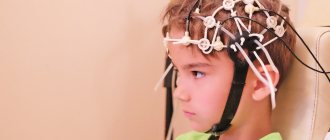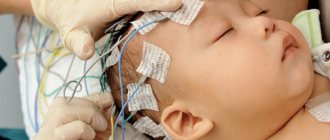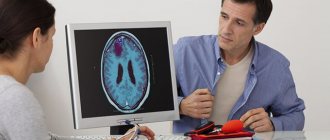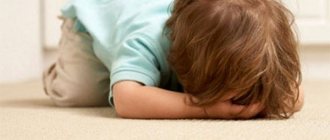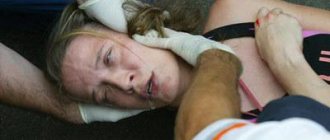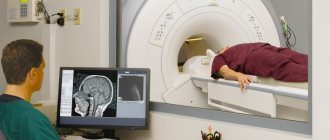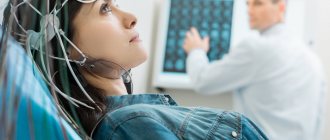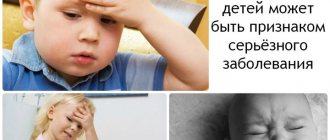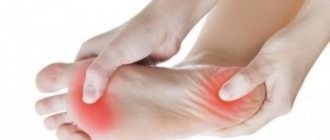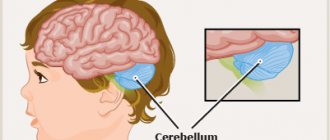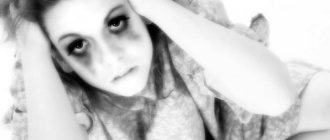Concept and features
Epilepsy belongs to the category of pathologies that manifest themselves as a result of disruption of certain parts of the brain .
In medical practice, this term combines a group of diseases whose symptoms are accompanied by the occurrence of regular stereotypical seizures occurring in different forms.
Convulsive conditions may be accompanied by loss of consciousness and may be tonic-clonic or myoclonic in nature.
Attacks occur suddenly, without provoking factors.
Features of the disease:
- an epileptic attack is a disorder of autonomic processes, mental activity and motor mechanisms;
- The development of epilepsy can occur over a long period of time in an asymptomatic form (seizures appear from the moment of critical damage to certain parts of the brain).
Risk factors and groups
Provoking factors for the development of epilepsy in newborns are:
- Bad habits of the mother during pregnancy.
- Infectious diseases suffered by the woman (influenza, rubella, mumps).
- Sexually transmitted infections (chlamydia, ureaplasma, syphilis, hepatitis).
- Use of medications during pregnancy.
- Serious chronic diseases of a woman leading to fetal hypoxia (heart disease, kidney dysfunction).
- Long anhydrous period during childbirth.
- Use of general anesthesia for caesarean section.
Observing children under 2 years of age, doctors concluded that most often an attack can be caused by an increase in temperature or a lack of some vitamin, for example, magnesium. In addition, it has been noted that babies may have a skull injury received during childbirth. If the child is from 2 to 14 years old, then the cause most often cannot be established.
Signs of epilepsy in children under 2 years of age may include sudden headache, fever, nausea and loss of consciousness. In this case, we can talk about an infection that has affected the body, for example, toxoplasmosis or malaria.
If the baby has been in the sun for a long time, then the attack appears simultaneously with a sharp rise in temperature. Its cause is heatstroke.
In cases where certain medications have been prescribed, signs of epilepsy in children under 2 years of age may occur while taking one of them or, conversely, stopping them.
Causes
The main causes of epilepsy in children include genetic predisposition and negative effects on the brain of external or internal factors.
A tendency to pathology can manifest itself at the stage of intrauterine development of the baby or in the first years of his life.
Children aged five to eleven years are at risk. The causes of epilepsy are directly related to the state of the brain and the functioning of its certain systems.
provoke epilepsy in a child:
- uncontrolled use of potent medications during pregnancy;
- genetic predisposition;
- congenital brain abnormalities in children;
- alcohol or drug abuse during pregnancy;
- damage to the cephalic circulation of ischemic nature;
- complications of brain injury;
- chromosomal pathologies (for example, Down's disease);
- critical shortage of vital substances in the body;
- consequences of complications of infectious diseases;
- complications of severe neonatal jaundice;
- hereditary neurocutaneous diseases;
- progression of brain tumors;
- congenital and acquired diseases of the nervous system;
- consequences of birth injuries.
Epilepsy in children: first symptoms, causes and treatment
Signs of epilepsy in children, noticed for the first time, seriously frighten parents.
Severe convulsive seizures that suddenly seize a healthy-looking baby seem like a bolt from the blue. The first thing moms and dads need to do is pull themselves together and examine the baby. Then you need to learn as much as possible about epilepsy in children and master the techniques of effectively helping the patient. It is important to understand: the disease is serious and insidious, but it can be controlled and treated if adequate conditions are created for this.
The mechanism of the disease
What is epilepsy in children? Medical studies have shown that this pathology is neurologically chronic and is caused by abnormal brain activity. It affects every one of the hundred inhabitants of our planet. Children with epilepsy are diagnosed several times more often than adults. The target of falling illness is babies under one year old.
The mechanism of development of epileptic seizures is associated with an increase in a certain area of the brain in the bioelectrical activity of its functional structures - neurons. These cells form a focus of congestive pathological excitation, the so-called epileptic focus. When, for one reason or another, a bioelectric impulse is discharged, activating the cells of the entire brain, an attack of epilepsy occurs.
The child falls unconscious, his body shakes in convulsions. After a few minutes, the tension gives way to muscle weakness. This is a manifestation of the fact that the electrical activity of neurons fades and goes into a “sleeping” mode. With the return of consciousness, the patient does not remember what happened.
Causes of the disease
In order to choose the right strategy for correcting the disease, you need to find out its etiology. Doctors distinguish several causes of epilepsy in children:
- Heredity. Scientists have identified a substance—dopamine—that is responsible for inhibiting overexcited neurons. Its volume is programmed in the genes: if parents have epileptic seizures, then there is a chance that their offspring will inherit them.
- Malformations of the fetal brain. The health of the future person in the womb is influenced by everything: at what age she conceived (middle-aged first-born women are included in the risk group), what illness she had, how she was treated, whether she abused drugs or alcohol. Poisoning of the embryo with toxic substances is the main cause of brain pathologies.
- Birth injuries. The causes of epilepsy often lie in the excesses that accompany the birth process. The baby's brain can be damaged by the midwife's forceps, prolonged labor, or squeezing the newborn's neck with the umbilical cord.
- Inflammatory diseases of the brain and its membranes: encephalitis, meningitis, arachnoiditis.
- Febrile convulsions during colds can reveal epilepsy in children with a family history.
- Traumatic brain injuries. Mechanical blows to the head often lead to the appearance of epileptogenic foci in the brain.
- Volumetric neoplasms. Tumors pressing on the brain can cause seizures in children.
- Metabolic disorders manifested by hyponatremia, hypocalcemia, hypoglycemia.
- Cerebral blood flow disorders.
- Teenagers' addiction to ephedrine, amphetamines and other drugs.
Important: the inflammatory disease “meningitis” can be fatal! It is very important to be able to recognize it in time. How? Read the answer in this article.
Types of disease
Depending on the pathogenesis, epilepsy in childhood is differentiated by specialists into three groups:
- idiopathic: stated if the symptoms of the disease appear as a result of a genetic factor, but without significant pathologies in the brain;
- symptomatic: considered a consequence of brain defects due to developmental anomalies, injuries, neoplasms;
- cryptogenic: recorded by doctors in cases where the disease appeared due to unidentified causes.
Symptomatic epilepsy in children differs in the area of localization of the pathogenic focus.
And depending on its location, it manifests itself in several types:
- frontal;
- parietal;
- temporal;
- occipital;
- chronic progressive.
The listed types of epilepsy manifest themselves in different ways. For example, frontal occurs only at night; For the temporal lobe, blackouts of consciousness without pronounced convulsive symptoms are characteristic.
Finding out the causes of the disease and its type helps to choose an adequate line of combating it. However, this is not enough for successful treatment: it is important to promptly recognize the first signs of epilepsy in a child.
Main signs of the disease
Symptoms of epilepsy in children are sometimes mistaken by hapless adults for excessive physical activity. This is the main reason for the late detection of a dangerous disease. Another common mistake is to think that an epileptic seizure can only involve convulsions and foaming at the mouth.
In order not to waste precious time, parents of children need to have a detailed understanding of the clinical picture by which childhood epilepsy is recognized.
Its features are quite diverse:
- Generalized convulsive seizures. They begin with an alarming harbinger - an aura. At this stage, the patient feels something like a breath running through the body or other unusual sensations. Then comes the stage of sharp muscle tension and holding the breath - the child falls screaming. The turn of convulsions comes, the eyes roll back, foam appears at the mouth, spontaneous urination and bowel movements may occur. Convulsive twitching can affect the entire body or muscle group. The attack lasts a maximum of 20 minutes. When the convulsions stop, the patient comes to his senses for a few moments and immediately falls asleep, exhausted.
- Nonconvulsive (minor) seizures. These not always noticeable attacks of epilepsy in children are called absence seizures. It all starts with the baby suddenly freezing with a blank look. It happens that the patient’s eyes are closed and his head is thrown back. For 15-20 seconds he does not perceive anything. Having emerged from a painful stupor, he returns to the interrupted business. From the outside, such pauses may seem thoughtful or absent-minded.
- Atonic seizures. The manifestation of attacks of this kind consists of a sudden loss of consciousness and muscle relaxation. They are often mistaken for fainting. The frequency of such conditions should be alarming.
- Baby spasm. Epilepsy in a baby can be manifested by a sharp raising of the arms to the chest, an involuntary tilt of the head and body forward when straightening the legs. This happens most often with children 2-4 years old when waking up in the morning. The attack lasts for several seconds. By the age of 5, the alarming manifestations of the disease either disappear or take a different form.
- Speech disturbance for several minutes while maintaining consciousness and the ability to move.
- Frequent nightmares, causing the baby to wake up screaming and crying.
- Sleepwalking.
- Regular headaches, sometimes causing nausea and vomiting.
- Sensory hallucinations: visual, olfactory, auditory, gustatory.
The last four signs do not necessarily indicate epilepsy. If such phenomena begin and begin to recur repeatedly, parents need to conduct a psychoneurological examination of the child.
Seizures in infants
The question of how to recognize epilepsy in a child under one year old is extremely important. In infancy, the disease often progresses atypically. Parents need to be extremely attentive to the condition and behavior of the newborn.
The initial stage of epilepsy in children under one year of age is characterized by the following signs:
- sudden fading;
- cessation of swallowing movements;
- throwing back the head;
- trembling eyelids;
- an empty, seeing nothing look;
- complete contactlessness.
After this, loss of consciousness and convulsions occur, not always accompanied by spontaneous bowel movements and urination. It should be noted that epilepsy in children under one year of age has a kind of prelude and completion. Harbingers of an attack are increased tearfulness, excessive excitability, and febrile temperature. After the seizure ends, the baby does not always fall asleep.
Diagnostic methods
Diagnosis of epilepsy in children involves a step-by-step examination of a small patient:
- Taking an anamnesis: finding out the moment of the first attacks, symptoms accompanying the attack, conditions of intrauterine development and childbirth, the presence of neurological diseases and addictions in parents.
- Basic instrumental technique: electroencephalographic study with video recording, which provides complete information about the bioelectric activity of the brain and the occurrence of defects in its structure.
- Additional methods used to clarify the diagnosis and establish the cause of the disease: MRI and CT scan of the brain, blood tests to determine metabolic and immune status, lumbar puncture.
- Studies as part of differential diagnosis: ophthalmoscopy, ultrasound of the cardiovascular system and other examinations prescribed by the attending physician.
Such an extensive diagnostic complex allows you to confidently confirm or exclude the presence of epilepsy.
On the road to healing
To the question of whether epilepsy in children can be treated, today's medicine gives a positive answer. The success of therapy depends both on the professionalism of the doctors and on the attitude of the parents.
The latter must be prepared for the fact that it will take a long time to treat epilepsy in a son or daughter, without interrupting the course even for a day.
What is required from parents:
- provide the baby with a diet with limited fluid and salt;
- organize a rational daily routine with leisure breaks;
- eliminate stressful situations;
- limit your child’s access to TV and computer;
- make it a habit to walk in the fresh air, but avoid prolonged exposure to the sun or independent swimming in a pond or bath;
- Encourage your child to play safe sports: badminton, tennis, cross-country skiing, etc.
During a seizure, you need to place the baby on his side in a safe place. You cannot restrain convulsions, unclench your jaws, or give medicine or water. The task of the parents of an epileptic is to prevent him from harming himself.
Drug treatment of epilepsy in children is determined taking into account the age characteristics and condition of the patient. The main role is given to anticonvulsants.
It is recommended to take them with a gradual increase in dose. When the number of attacks decreases and their intensity decreases, the full age dosage is prescribed.
In the symptomatic form of the pathology caused by a tumor in the brain, the patient can be cured surgically. Before the operation, a consultation of a neurosurgeon, neurologist and psychotherapist gathers, the risks of invasive intervention and the opinion of the parents are taken into account.
If the danger of the operation is too high, the question is “how to treat the patient?” decided in favor of drug therapy.
Disease prognosis
In 80% of cases, persistent and long-term treatment of epilepsy in children leads to relief from a serious illness. The immediate environment of little epileptics should help them develop normally and find their place in society. Patience, wisdom and love of parents play a huge role in this.
Source: https://golovnie-boli.com/deti-i-beremennye/epilepsiya-u-detej.html
Classification
certain varieties are characteristic of childhood .
Classification is carried out depending on the degree of brain damage.
The main types of childhood epilepsy are focal and generalized types.
In the first case, the pathology affects specific areas of the brain, in the second, it spreads to both hemispheres. These types of pathology are further divided into certain varieties.
Classification of epilepsy by the nature of the attacks:
- True form (the attack is accompanied by loss of consciousness, convulsions, increased salivation, involuntary defecation and urination, as well as respiratory arrest).
- Absence type (an epileptic seizure manifests itself in the form of a characteristic “freezing” of the child in one position; in some cases, auditory and visual hallucinations are possible).
- Temporal form (during an attack the child repeats certain sounds or movements, this can be clapping his hands, smacking his lips, blinking, laughing or playing individual sounds).
- Frontal or nocturnal epilepsy (seizures bother the child only at night; symptoms of sleepwalking or involuntary shuddering of the limbs may appear).
- Rolandic form (convulsions manifest themselves in the form of tingling in certain areas of the neck, face, pharynx or in the oral cavity; this condition provokes cramps in the affected muscle areas and a sharp change in the child’s facial expressions).
Main types of illness
There are main types of epilepsy in children:
- Benign Rolandic. Manifests between the ages of 2 and 6 years. It is caused by immaturity of the brain, in which a zone of increased convulsive readiness is formed. Attacks begin during sleep and are expressed in the form of numbness, twitching of one half of the face and body. The disease is considered benign because the symptoms weaken as people get older and go away by puberty.
- Febrile convulsions of infants. In infancy, when the temperature rises, the baby begins to have convulsions. They manifest themselves as slight twitching of the limbs or full-blown attacks with loss of consciousness. If such phenomena occur constantly and are not always associated with temperature, then we are talking about epilepsy.
- Juvenile myoclonic. Manifests in adolescence. After waking up, a teenager begins to have myoclonic seizures in the form of body tension and twitching of the limbs. In severe cases, the attack is accompanied by loss of consciousness. Typically, seizures are preceded by mental overstrain, stress, and flashing lights. The frequency of attacks can be reduced with the help of medications, but the disease will accompany the person throughout his life.
- Infantile spasms. The pathology appears before the age of one year and disappears by 3-4 years. The baby suddenly begins to experience muscle spasms, he sharply bends and straightens his body, bends his arms. Such cramps can occur several times a day. Such children often experience developmental delays and mental disorders.
- Lennox-Gastaut syndrome. A malignant form of the disease, accompanied by attacks of various types. This type of disease is difficult to treat. A characteristic symptom is mental retardation, progressing every year.
- Jackson's. It is a consequence of organic brain damage due to injuries, infections, tumors. An EEG can accurately determine which segments of the brain are damaged. Symptoms of the disease: unilateral tonic muscle contractions. As the disease progresses, attacks become generalized.
How does it manifest?
The symptoms of epilepsy attacks in infants and older children are different .
In the first case, the baby may suddenly stop looking at some object and stop reacting to the environment.
This condition is preceded by excessive irritability, tearfulness or increased body temperature. The attack lasts from a few seconds to twenty minutes.
Weakness of the body after a seizure may persist for several hours.
Common symptoms and signs of epilepsy include the following:
- the child’s tendency to have convulsive states of varying intensity;
- regular occurrence of atonic attacks (loss of consciousness combined with muscle weakness);
- sudden attacks of loss of consciousness (including stopping breathing);
- auditory or visual hallucinations during attacks;
- periodic trembling of the upper and lower extremities;
- blue discoloration of the skin during attacks;
- attention deficit hyperactivity disorder;
- chronic headaches;
- attacks in the form of sudden contractions and relaxations of facial muscles;
- sudden cries of a child combined with convulsive conditions;
- tendency to involuntary urination.
Seizures in epilepsy can be of three types - hysterical, cataleptic and narcoleptic .
In the first case, the child begins to roll on the floor, bang his hands on it, cry and moan (the provoking factor is a crowd of large numbers of people or psychological trauma).
A cataleptic attack occurs as a result of emotional overstrain and is accompanied by stupor and muscle weakness. A narcoleptic seizure manifests itself as sudden and excessive sleepiness in a child.
Symptoms
The most recognizable symptom of the disease is seizures, but they appear only in severe forms.
What is dangerous about epilepsy in children is its unpredictability. There are more than 60 different subtypes of the disease, each of which has its own distinctive features and manifestations, which are quite difficult to determine at first glance.
What an epileptic attack looks like in childhood and how to recognize the disease at an early stage can be learned by examining the initial signs of the disease in young children.
In infants
Pathology in newborns and one-year-old babies manifests itself in the same way. You should consult a doctor if your baby exhibits at least one of the following characteristics:
- the muscles on the face temporarily become numb, turning into a motionless mask, then begin to rapidly contract.
- during feeding, the triangle near the lips turns blue (from the upper lip to the nose).
- The gaze is fixed at one point for a long period of time.
- involuntary movements of the limbs occur.
- there is a prolonged lack of reaction to any sounds, at the same time a bowel movement is possible, and then a crying attack.
Older guys
The older a person becomes, the more pronounced the manifestations of the disease become.
The signs and symptoms of epilepsy before 2-3 years and after 5-8 years are completely different in their severity.
In addition to the physical symptoms described above, the children’s character and behavior deteriorate.
They become anxious, aggressive, irritable. It is difficult for them to build relationships with peers and others, and to study. At the same time, it is not always possible to determine exactly how an epilepsy attack begins, what it looks like and how long it lasts in a child at first glance. This is due to the fact that each type of pathology has its own characteristics.
Forms of the disease
Doctors know very many types of epileptic syndrome, differing in symptoms, location of lesions in the brain, and age at which they first appear.
But some options are considered the most common, appearing from birth:
- Rolandic. The lesion is located in the Rolandic (central) groove. Seizures occur from 3 to 13 years of age and disappear upon reaching puberty. During the period of neuronal excitation, the child feels numbness in the facial muscles and tingling. Speech disappears, saliva begins to be released more actively. The duration of symptoms is 3-5 minutes. The patient remains fully conscious, memory does not suffer.
- Nocturnal type - epilepsy manifests itself as hidden symptoms in children at night, often only up to 3 years of age. However, it is possible that seizures may persist into later life. The attacks are painless. Accompanied by sleepwalking, enuresis, trembling of the limbs during sleep, and severe irritability.
- Absence epilepsy, the manifestations of which are first detected in a child at 5-8 years of age, is considered the mildest form. After puberty, it may disappear. Or it will degenerate into a more severe form. Symptoms: periodic freezing of the gaze, synchronous turns of the head and limbs, memory loss during attacks.
- Idiopathic. The patient does not show deviations from the norm either in intellectual or physical development, but periodically he experiences seizures. Convulsions with periodic loss of consciousness, increased salivation, short interruptions in breathing. No memories of the state remain in the memory.
Read also…. TOP 15 best pacifiers for newborn babies
Complications and consequences
Epilepsy attacks can harm a child’s health not only by the progression of brain pathologies, but also by the manifestation of convulsions .
During seizures, children can be seriously injured by foreign objects or by their own actions.
To prevent such consequences, parents need to know the first aid algorithm . In addition, epilepsy can disrupt the functioning of vital systems of the body, so treatment must be carried out promptly and fully.
The consequences of epilepsy can be the following factors:
- Status epilepticus (with this pathology, attacks occur at short intervals, the child does not have time to recover, which has an extremely negative impact on his general health).
- Injuries sustained by a child during an epileptic attack may be incompatible with life.
- Regular attacks and progression of pathology lead to the development of mental retardation.
- Epilepsy can provoke chronic aspiration pneumonia.
- Death is possible due to tongue retraction or aspiration of vomit.
Diagnosis of the disease in infants
Diagnosis of infantile epilepsy is somewhat difficult. First of all, it is necessary to differentiate true epileptic seizures from increased neuro-reflex excitability. The latter differs in that the movements of the limbs stop if they are held by hands.
To clarify the diagnosis, the following diagnostic methods are required:
- electroencephalogram;
- MRI, CT scan of the brain;
- Ultrasound of the brain.
It should be carried out during sleep and wakefulness, since convulsive activity can only be recorded during sleep. In addition, it is necessary to conduct a blood test for the levels of glucose, potassium, sodium, magnesium, and protein.
Despite the achievements of modern medicine, the causes of epilepsy have not yet been established. The primary factor is hereditary. A person inherits instability of brain neuron membranes.
Other provoking factors include:
- Chromosomal abnormalities (Down syndrome).
- Pathologies of intrauterine development. They can occur as a result of bad habits of the mother, infections, or fetal hypoxia.
- Difficult childbirth. Pathology can be provoked by: a long anhydrous period, the use of vacuum extraction, entanglement with the umbilical cord.
- Premature birth. The brain of a premature baby is not yet fully formed, so among children born prematurely, epilepsy is several times more common.
In older children, in addition to hereditary forms, symptomatic epilepsy also occurs, that is, arising due to the influence of unfavorable external factors:
- Serious infectious diseases: influenza, meningitis, encephalitis.
- Head injuries.
- Brain tumors.
However, most often children are diagnosed with the idiopathic form of the disease, when the cause cannot be determined.
First aid during an attack
An epilepsy attack occurs suddenly. There is a certain algorithm of actions that helps not only alleviate the child’s condition, but also reduce the time of the seizure .
During an attack of epilepsy, it is important to prevent the baby from receiving injuries that he may receive from a fall or convulsions.
Under no circumstances should you try to open the child’s jaws, give him water to drink, or perform artificial respiration. Such actions may cause additional complications.
First aid algorithm for a child during an attack:
- Remove all objects that could cause injury.
- Unbutton or remove clothing if breathing is difficult.
- Provide fresh air (open the window).
- Turn the child's head to the side (to prevent the tongue from falling into the pharyngeal space).
- Call an ambulance (if the attack lasts longer than five minutes).
Help with cramps
If your child has a seizure, do not be alarmed. It is necessary to provide first aid to the victim. As soon as the convulsions begin, the patient must be placed on the bed. It should be wide enough so that he doesn't fall. If the child is away from home at this time, then the floor will do. There should be no sharp objects or hard furniture nearby. In general, put it away from anything that could hurt a small patient.
To prevent the baby from suffocating, you should try to turn him on his side.
Contrary to the belief that you need to put a spoon in your mouth, doing this is strictly prohibited. The patient should not have any objects in his mouth. It is also prohibited to hold the child's tongue with your fingers. Most often, the spasm lasts a few seconds. After the seizure stops, you need to check whether the victim is breathing. If breathing is not heard, artificial respiration must be performed using the mouth-to-mouth method.
Attention! It is strictly forbidden to perform artificial respiration when convulsions continue!!!
You need to stay close to the child until his consciousness is restored. Until then, any liquid or medicine is prohibited. If an elevated temperature is detected, the patient is given a suppository containing paracetamol rectally.
You should call an ambulance immediately if:
- Convulsions occur for the first time.
- Their duration is 5 minutes or more.
- After they have passed, they repeat after a short period of time.
- When convulsions occur, the child breathes unevenly and very heavily.
Conclusion
It is important to know that signs of childhood epilepsy appear more often than in adults. However, you should not expect instant results. Treatment is long-term and can sometimes last a lifetime. Most often, one medication is enough. In this case, only a doctor should prescribe a medicine or change its dose.
Diagnostics
Detection of epilepsy in a child is carried out in two stages .
Primary diagnosis consists of collecting a history and visual examination of the small patient.
At the second stage of examining the child, various laboratory and instrumental procedures are used. Particular attention is paid to studying the state of the brain and identifying deviations in the performance of its individual functions.
procedures are used for diagnosis :
- EEG of the brain;
- lumbar puncture;
- MRI and CT of the brain;
- night EEG monitoring;
- X-ray of the skull;
- PET scan of the brain;
- immunological blood test;
- study of biochemical parameters.
Baby spasm
A special type of epilepsy in a child (in some sources the name thoracic epilepsy is found), which is accompanied by pulling the arms to the chest and tilting the head down. Newborns experience frequent involuntary head nodding.
The complex form is burdened by absence seizures.
It is not difficult to recognize a child's spasm; you just need to observe the baby at the moment of his awakening, since the spasm appears precisely after sleep, in the first minutes.
This type of disease is dangerous because it does not go away without a trace, but affects the intellectual and psychosomatic development of the child.
This disease can appear between the ages of one and five years.
Subsequently, infantile spasm transforms into one of the most common forms of childhood epilepsy.
Treatment
Epilepsy therapy involves the use of complex techniques. Drug treatment is necessarily complemented by creating the most favorable conditions for the little patient.
Stressful situations and the impact of negative external factors should be excluded.
Additionally, attention should be paid to the child’s diet, adherence to the daily routine and strengthening the body’s immune system. The course of therapy is prescribed individually .
Treatment methods for epilepsy in children:
- anticonvulsants (Difenin, Phenobarbital);
- phenobarbital derivatives (Gluferal);
- antiepileptic drugs (Sibazon, Cerebrolysin);
- derivatives of valproic acid (Depakine);
- drugs from the benzodiazepine group (Diazepam);
- new generation anticonvulsants (Lamotrigine, Levetiracetam);
- non-drug therapy (psychotherapy, hormonal therapy, immunotherapy, biofeedback therapy);
- surgical intervention (in the presence of tumors in the brain that provoked the disease).
Forecast
With early diagnosis and timely treatment, epilepsy can be eliminated almost completely .
If the disease is detected in an infant, then special therapy can eliminate the occurrence of seizures and restore impaired brain functions.
When epilepsy manifests itself in older children, the main goal of the course of treatment is to reduce the risk of recurrent exacerbations of the pathology. Unfavorable prognosis is possible only if the symptoms of epilepsy and improper therapy are ignored for a long time.
Symptoms in childhood
As the baby gets older, the symptoms become more pronounced.
Children experience epileptic seizures of the following types:
- Absence seizures. The child simply freezes in one position for a few seconds and stops responding to external stimuli. Afterwards the child returns to the interrupted activity. Such attacks continue for several years, then either pass or transform into another form.
- Atonic seizures. They are expressed in a sudden loss of consciousness, from the outside it looks like a regular faint.
- Baby spasms. Usually happens in the morning after sleep. Cramps affect a specific muscle group. Symptoms disappear by 5-6 years or change into other types.
- Generalized convulsive seizures. They begin with an aura, then all the muscles of the body tense, the patient loses consciousness, and involuntary convulsions occur. The attack lasts up to 30 seconds, then the patient does not remember what happened to him. After a seizure, the child usually falls asleep for a long time.
In addition to the above, children have other symptoms of the disease that should alert parents:
- Causeless headache accompanied by nausea and vomiting.
- Sudden short-term speech impairment. The child suddenly cannot pronounce familiar words.
- Nightmares, sleepwalking, hallucinations. Often the baby screams in his sleep, cries, and wakes up abruptly.
- In infants, the disease is manifested by trembling of the eyelids and throwing back of the head.
Nightmares or seizures do not always indicate epilepsy. They can also accompany other diseases.
An accurate diagnosis can only be made using an electroencephalogram.

